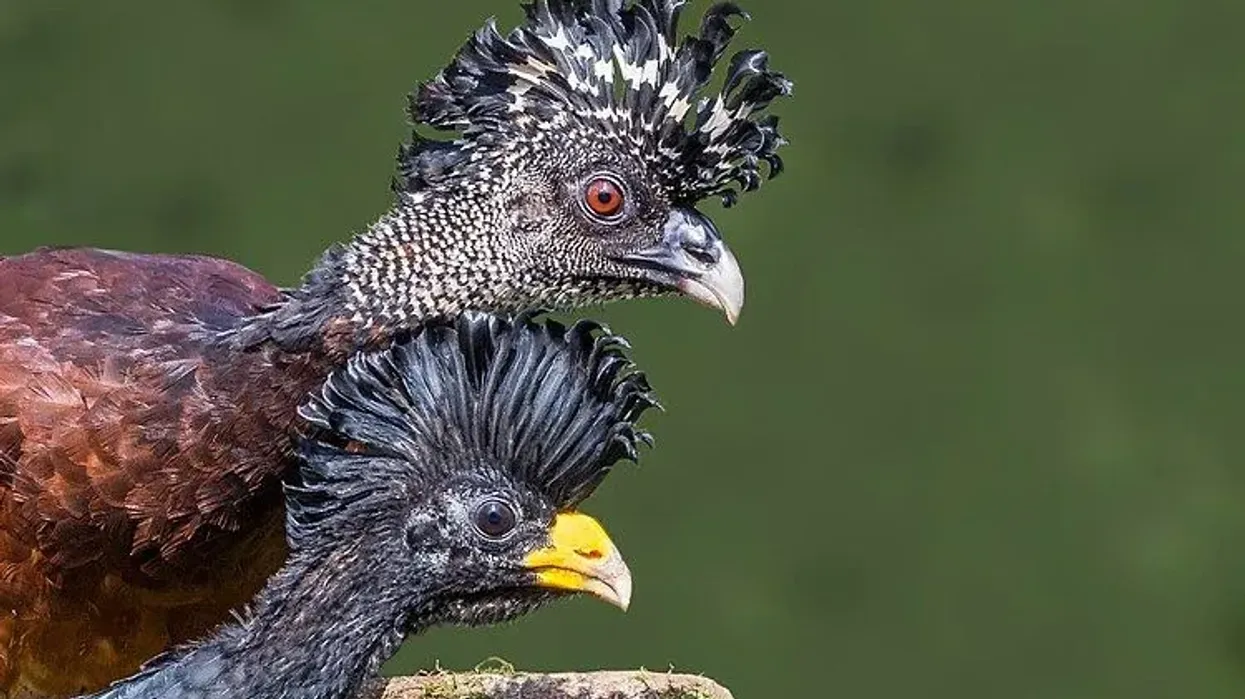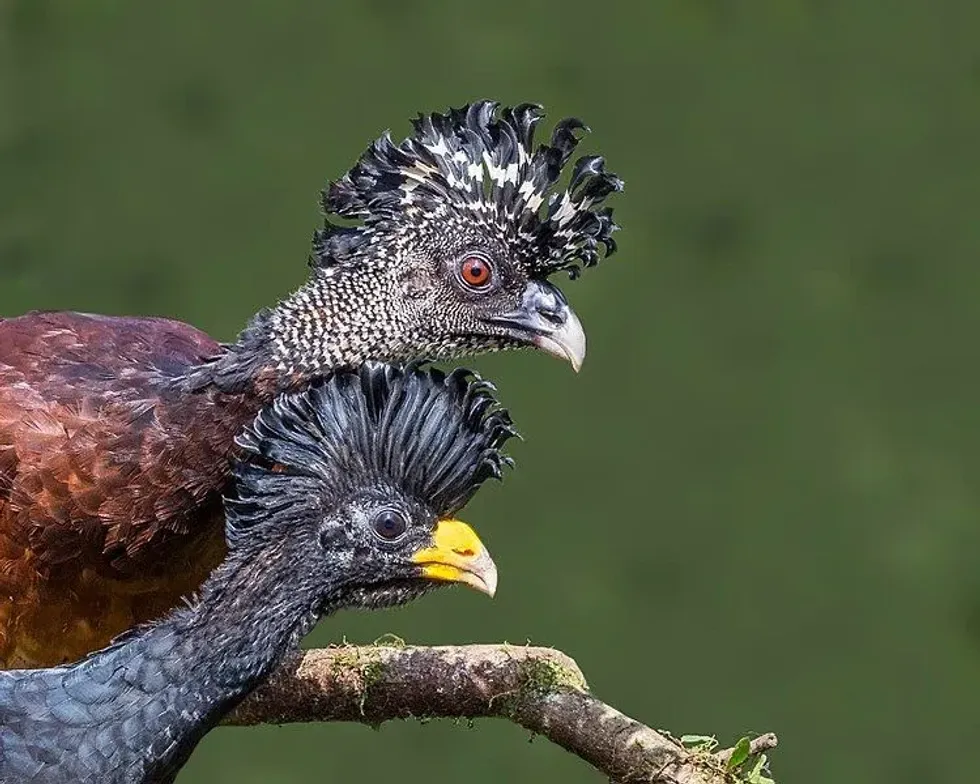The great curassow (Crax rubra) is a bird of the Cracidae family, found in North and South America. Their distribution range is from eastern Mexico to Central America and also includes western parts of Colombia and northwestern Ecuador.
The great curassow has two subspecies, with scientific names Crax rubra rubra and Crax rubra griscomi.
These birds spend most of their time on the ground and can be identified by the forward curling feathers on their head. The male bird also has a yellow part on its bill, which females lack.
The habitat of the great curassow is primarily rainforests. However, some of them also reside in drier forests. Their diet is omnivorous, with fruits in major proportion and insects or small animals in smaller quantities. These curassows forage on the ground.
Unfortunately, this species is under severe threat of endangerment. Owing to illegal pet trades, hunting, and habitat loss, their numbers are rapidly decreasing in the wild. Conservation efforts are underway to bring back their population and increase their natural range.
To learn more fun and strange facts about the great curassow, keep reading! For more relatable content, check out these mountain bluebird facts and pitta bird facts for kids.
Great Curassow Interesting Facts
What type of animal is great curassow?
The great curassow (Crax rubra) is a kind of bird found in Central and South America.
What class of animal does great curassow belong to?
These birds belong to the class Aves and are part of the family Cracidae.
How many great curassows are there in the world?
According to the International Union for Conservation of Nature or IUCN, the population of this curassow species is decreasing, with estimations of only 40,000-50,000 individuals in the wild. In Ecuador, there are estimated to be less than 100 great curassows. To add to that, the population of the subspecies Crax rubra griscomi has declined drastically, as well.
Where does great curassow live?
The range of great curassows includes parts of Central America and South America. Their distribution is from eastern Mexico to western Colombia and northwestern Ecuador, including Central America, in between. The countries included in their range are Costa Rica, Colombia, Guatemala, and a few more.
What is a great curassow's habitat?
Great curassows mainly reside in any forested habitat. Rainforests in tropical or sub-tropical zones are their primary habitat.
However, in Costa Rica and the Yucatan of Mexico, they also occur in drier forests. They are also seen in plantations or cleared lands, rarely. Even though the great curassow spends a lot of time on the ground, they build their nest in trees.
Who do great curassows live with?
Great curassows are usually found in pairs or in small groups with members of their own species, unlike flame bowerbirds. Their groups can have as many as six birds, foraging together.
How long does great curassow live?
These birds can live for up to 24 years in captivity.
How do they reproduce?
The breeding season varies depending on the bird's location. Great curassows are monogamous in nature. The nest is constructed by birds of both sexes. After mating, the female great curassow lays two eggs. The two eggs are incubated for 33 days before the chicks hatch out.
What is their conservation status?
The conservation status of the great curassow has been marked as Vulnerable by the International Union for Conservation of Nature or IUCN. These birds are threatened by hunting, illegal pet trade, and habitat loss. The subspecies Crax rubra griscomi have become very rare or locally extinct in their natural range.
Great Curassow Fun Facts
What do great curassows look like?
Great curassow birds have a distinct look, that separates them from other kinds of bird species. The male and female birds are quite different in appearance and exhibit sexual dimorphism. Males mainly have black plumage with white bellies.
They stand out due to the curly crest on their heads. They also have a yellow part on their bill.
Females lack both of these but are seen in three different morphs, which are barred, rufous, or dark plumage. Their long tails and wings can be blackish, rufous, or barred. Both sexes have forward curling feathers on their heads.
How cute are they?
The great curassow's appearance is not only very cute but fascinating to look at just like a peach-faced lovebird.
How do they communicate?
A great curassow bird mainly communicates through calls and vocalizations. The great curassow male utters resonating 'oomp' notes. The female bird has been noted to make 'humm' or 'hoot hoot' sounds. Their alarm call sounds like a high-pitched 'peep'. Additionally, males are also known to sing when breeding season is approaching.
How big is great curassow?
The male and female great curassow vary in size. The length of males is between 34.2-36.2 in (87–92 cm), while for females it is 30.7-33 in (78–84 cm).
They are about 36 in (91.4 cm) tall. When compared to another species of the curassow bird, known as the yellow-knobbed curassow who are between 33-37 in (84-94 cm) in length, it can be observed that they are slightly longer than great curassows. Compared to ani birds, they are much longer.
How fast can a great curassow fly?
The great curassow is not a strong flier and spends most of its time on the forest floor. However, sometimes they can fly to sit on trees of medium height.
How much does great curassow weigh?
The weight of the male great curassow is between 8-10.5 lb (3.6-4.8 kg), while the female bird weighs between 6.8-9.4 lb (3.1-4.3 kg).
What are the male and female names of the species?
The male and female birds of this species are known as male great curassows and female great curassows, respectively.
What would you call a baby great curassow?
A baby great curassow is known as a chick.
What do they eat?
These birds are omnivorous in nature. Their diet mainly consists of fallen fruits, berries, and seeds. Occasionally, they also forage on the forest floor for insects and small animals like lizards and rodents. Their strong bill helps in their foraging activity. Foraging behavior is usually displayed in pairs or in small groups.
Are they dangerous?
If this bird feels their nest or offspring is under threat from any human, it can attack by leaping and scratching the head and eyes of the person.
Would they make a good pet?
Unlike frigates, these birds can make good pets. However, the great curassow is not allowed to be kept as a pet in some parts of its range, while in others there are no such restrictions. Additionally, the population of this bird species is threatened, and domesticating them might further decrease their numbers in the wild.
Did you know...
The yellow part possessed by the male curassows on their bill becomes more prominent during their breeding or mating season.
How to raise great curassow chicks?
To raise great curassow chicks, they should be provided with a brooder box that has enough space for them to walk around or fly in, along with proper sanitation. They might also need to be hand-fed, till they learn to eat on their own. Their diet should contain starter crumbs, fruits, and greens.
Colors of the great curassow
Males and females have different coloration in this species. Male great curassows are primarily black with a curled crest and white belly. They also have a yellow knob on their bill. The great curassow female has three different morphs.
Their barred morph is seen with barred wings and tails. In the rufous morph, only the tail is barred and the rest is reddish-brown. Finally, the dark morph is characterized by a black-toned neck and tail. The wings might have some barring in this morph.
Here at Kidadl, we have carefully created lots of interesting family-friendly animal facts for everyone to discover! For more relatable content, check out these red-bellied woodpecker interesting facts and common kingfisher facts pages.
You can even occupy yourself at home by coloring in one of our free printable great curassow coloring pages.









